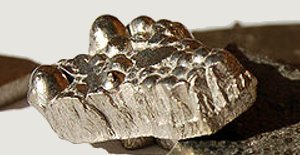Cobalt
Cobalt-based blue pigments (cobalt blue) have been used since ancient times for jewelry and paints, and to impart a distinctive blue tint to glass, but the color was later thought by alchemists to be due to the known metal bismuth. Miners had long used the name kobold ore (German for goblin ore) for some of the blue-pigment producing minerals; they were named because they were poor in known metals and gave poisonous arsenic-containing fumes upon smelting. In 1735, such ores were found to be reducible to a new metal (the first discovered since ancient times), and this was ultimately named for the kobold.
Today, some cobalt is produced specifically from various metallic-lustered ores, for example cobaltite (CoAsS), but the main source of the element is as a by-product of copper and nickel mining. The copper belt in the Democratic Republic of the Congo and Zambia yields most of the cobalt metal mined worldwide.
Cobalt is used in the preparation of magnetic, wear-resistant and high-strength alloys. Cobalt silicate and cobalt(II) aluminate (CoAl2O4, cobalt blue) give a distinctive deep blue color to glass, smalt, ceramics, inks, paints and varnishes. Cobalt occurs naturally as only one stable isotope, cobalt-59. Cobalt-60 is a commercially important radioisotope, used as a radioactive tracer and in the production of gamma rays.
Cobalt is the active center of coenzymes called cobalamins, the most common example of which is vitamin B12. As such it is an essential trace dietary mineral for all animals. Cobalt in inorganic form is also an active nutrient for bacteria, algae and fungi.
Occurrence
The stable form of cobalt is created in supernovas via the r-process. It comprises 0.0029% of the Earth's crust and is one of the first transition metal series.
Cobalt occurs in copper and nickel minerals and in combination with sulfur and arsenic in the sulfidic cobaltite (CoAsS), safflorite (CoAs2) and skutterudite (CoAs3) minerals. The mineral cattierite is similar to pyrite and occurs together with vaesite in the copper deposits of the Katanga Province. Upon contact with the atmosphere, weathering occurs and the sulfide minerals oxidize to form pink erythrite ("cobalt glance": Co3(AsO4)2·8H2O) and spherocobaltite (CoCO3).
Cobalt is not found as a native metal, but it is mainly obtained as a by-product of nickel and copper mining activities. The main ores of cobalt are cobaltite, erythrite, glaucodot and skutterudite.
| Symbol | Co | |
| Atomic Number | 27 | |
| Atomic Weight | 58.9332 | |
| Oxidation States | +2,+3 | |
| Electronegativity, Pauling | 1.88 | |
| State at RT | Solid, Metal | |
| Melting Point, K | 1768 | |
| Boiling Point, K | 3143 |
Appearance and Characteristics
Harmful effects:
Cobalt and its compounds are considered to be slightly toxic by skin contact and moderately toxic by ingestion.
Characteristics:
- Cobalt is a bluish-white, lustrous, hard, brittle metal. It is ferromagnetic.
- The metal is active chemically, forming many compounds. Cobalt stays magnetic to the highest temperature of all the magnetic elements (it has a Curie point of 1121oC).
Uses of Cobalt
- Cobalt is used in alloys for aircraft engine parts and in alloys with corrosion/wear resistant uses.
- Cobalt is widely used in batteries and in electroplating.
- Cobalt salts are used to impart blue and green colors in glass and ceramics.
- Radioactive 60Co is used in the treatment of cancer.
- Cobalt is essential to many living creatures and is a component of vitamin B12.
- Cobalt is also used in samarium-cobalt permanent magnets. These are used in guitar pickups and high speed motors.
